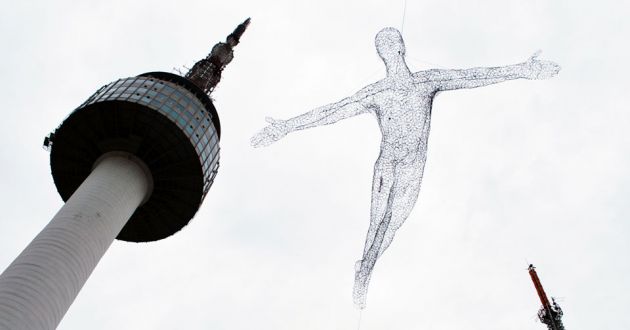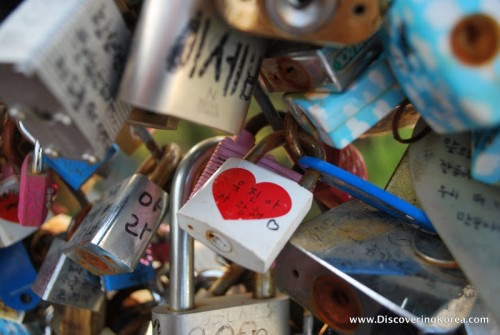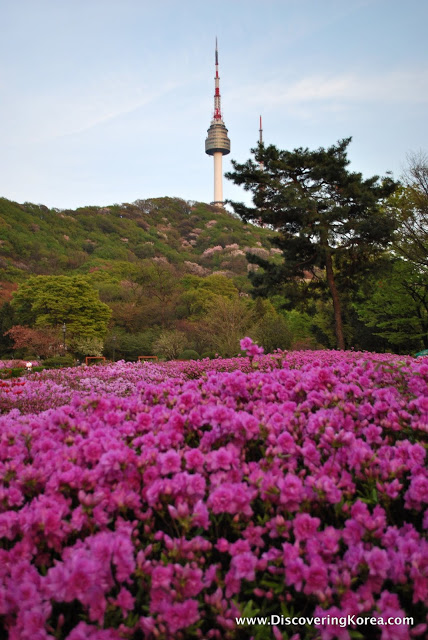Namsan Park and N Seoul Tower play a very important role in the daily life of Seoulites and visitors, alike. That’s because in a city as huge as Seoul, finding your bearings can be a challenge.

Thanks to these two Seoul icons – one natural, the other human-made – city folk can feel just a bit more secure when it comes to their sense of place.
When Yi Seong-gye (이성계) moved Korea’s capital to present-day Seoul in 1394, he protected it with 18 kilometers of fortress walls that connected four mountaintops. Namsan (남산), which means “south mountain,” formed the city’s southern border.
Of course, long ago Seoul spilled beyond those original walls. So what was the city’s southern limit is now its heart. And from various points throughout the city, N Seoul Tower can be seen rising atop Namsan.

It wasn’t until 1984, however, that Namsan Park (남산공원) was formally established. At nearly three million square meters, the park is one of Seoul City’s largest green spaces.
And despite being smack dab in the center of one of the world’s biggest cities, the much-loved park is reportedly home to over 600 plant and animal species.
Each year, 8.4 million people visit Namsan Park and N Seoul Tower, which translates to some 30,000 a day in the high season. In addition to enjoying well-maintained jogging paths, the park includes a library, a botanical garden and a swimming pool.
At the park’s northeast side there’s the Namsangol Hanok Village (남산골한옥마을). Built to resemble a Korean folk village, free traditional wedding ceremonies and cultural performances can be enjoyed there in the summer and fall.
No doubt, the park’s most popular attraction is N Seoul Tower. Built in 1969 and opened to the public 11 years later, the communication tower is approx. 237 meters tall, topping off at a half-kilometer above sea level.
To reach the tower, zero-emissions buses drive there while South Korea’s first cable car whisks people from the outskirts of the Myeong-dong Shopping District to the mountaintop.

Once there, visitors can enjoy a spacious plaza and platforms affording panoramic views of Seoul. Take a closer look, however, and you’ll see a safety fence that’s covered in thousands of padlocks.
These curious objects are symbols of love fastened by young couples. Inside N Seoul Tower is a café and three restaurants, including the revolving n.Grill. For some, the Teddy Bear Museum shouldn’t be missed… but personally, the highlight is the fantastic Sky Restrooms on the observation level.

Of course, Namsan Park and N Seoul Tower’s four observation platforms are the big draw. Helpful window displays indicate Seoul landmarks and world capitals.
Overall, the platforms can hold 1,100 people, and at 350 meters above sea level, they afford outstanding views of the city, day or night. Speaking of nightfall, should you be there to see it, the tower will be transformed into a piece of digital art.
Until midnight, colorful flames and other images are projected on the tower’s torso every hour.

Finally, since the 1990s, Seoul city officials have worked to restore Namsan Park and N Seoul Tower. In March 2009, the previous mayor unveiled a Namsan Renaissance master plan.
The project consisted of removing buildings, restoring the ancient Seoul Fortress (서울성곽) walls and extend jogging paths to 7.5 kilometers. At a cost of 232 billion won ($183 million), the project is scheduled to be completed in 2015.
For Your Information…
| Open: | Observatory: 10:00-23:00 (Sun-Thu), until 24:00 (Fri-Sat); Restaurant: 11:00-23:00; Exhibition Hall: 10:00-22:00 |
| Admission Price: | Observatory Admission: ₩9,000 (adults), ₩7,000 (youth), ₩5,000 (children) |
| Address: | Yongsan-gu Yongsan-dong 2(i)-ga San 1-3 |
| Directions: | Myeong-dong Station (#424) on Line 4, Exit 3 |
| Phone: | 02-3455-9277, 88 |
| Website: | Official Site |
About Matt Kelley
Matt Kelly is native of the US Pacific Northwest and is half-Korean by ethnicity. He lived in Korea for five years and has written hundreds of travel guides for Wallpaper, TimeOut, the Boston Globe and Seoul Magazine and was a host for several different variety shows on Korean radio and television.
